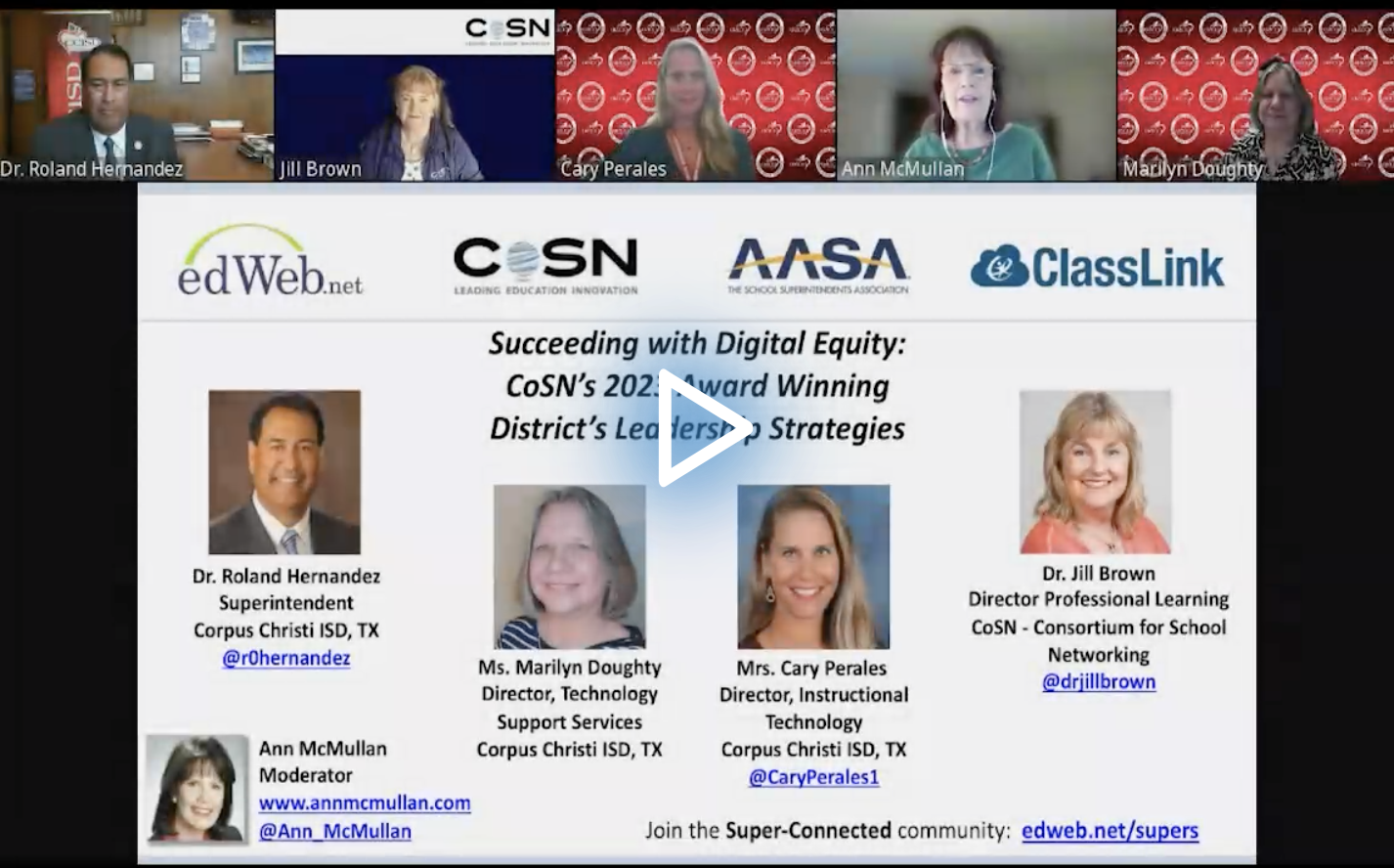Addressing the Digital Access Gap: One District’s Success
Watch the Recording Listen to the Podcast
This edLeader Panel is presented by CoSN and AASA.
Sponsored by ClassLink
What does it take for a school district to become an award winner? In the case of Corpus Christi Independent School District (CCISD), it was narrowing the digital access gap, landing it CoSN’s Community Leadership Award for Digital Equity.
CCISD has been striving to bring its vision of digital equity to life through a broad approach to meet all student needs, including devices, curriculum integration, and processes and systems to access and effectively use technology easily. To date, it has been successful.
During the edLeader Panel “Succeeding with Digital Equity: CoSN’s 2023 Award-Winning District’s Leadership Strategies,” CCISD leaders described the strategies and resources undergirding districtwide efforts to establish a safe, equitable, and effective digital landscape for all students.
Establishing Digital Equity: What It Takes
CCISD—serving families across economic status—has relied on innovation to shape its journey to equitable tech access for all students. Like most school districts, CCISD gave every student a Chromebook during the pandemic (using ESSER funds to continue the transition post-pandemic): The 1:1 ratio unearthed accessibility gaps.
Beyond making learning fun and increasing rigor and standards, the district had to ensure that all students had tech access at all times—in school and at home—across its 57 campuses and surrounding neighborhoods.
CCISD recognized that digital equity is more than devices for all; it also requires that students experience success and that teachers and leaders effectively, appropriately, and equitably use technology to provide quality learning. The district took strategic steps to achieve both, including:
- Engaging a technology standards coordinator to get devices into students’ hands and analyze usage reports to determine whether learners use the devices to their benefit.
- Training teachers to adapt to a blended learning environment during COVID by becoming more adept at using Canvas, a learning management system (LMS) that gives students equitable access to the district’s instructional resources and assignments and promotes collaboration among teachers. Parents can also access the LMS to see what their children are learning.
- Narrowing down accessibility tools to ensure access to everyone, resulting in the Accessibility Toolkit that showcases the tools to students, teachers, and parents.
- Providing students WiFi access in every classroom and outside common areas to expand the classroom setting.
- Installing classroom charging cabinets to secure the devices and keep them charged.
Developing and Delivering Information Technology: Leadership Commitment
Achieving digital equity required leadership to set and communicate goals to increase opportunities and accessibility for all students. In addition to device distribution, district teams:
- Promote the federal Affordable Connectivity Program, which provides discounted internet access to families. A team shares program details with families during open houses at high school campuses and helps them with the application process.
- Developed a security awareness program, leading to a 75% decrease in phishing attempts during the initiative’s first four operational months (and saved lots of district data). Staff have conducted in-person training on campuses and at administrative locations to highlight the need for security and the impact when it’s absent, driving individual responsibility for guarding data against exposure.
- Host the annual teacher-led, leadership-capacity-building Tech2Teach Conference to share with teachers what classrooms do to leverage technology for learning differentiation; invite parents to discover what students are learning and learn how to use Canvas or access the resources it provides; and help principals become comfortable with the technology they promote and implement at their campuses.
- Offer professional development to smaller surrounding school districts to support student learning (the district believes these students are their “kids,” too).
Effecting Change: Strengthening Community Awareness and Engagement
Community is essential to CCISD’s tech progress. From gathering input to sharing information, it maintains close ties with community members and parents to keep them in the loop, garner insight, and gain buy-in.
The district gathers information and feedback through surveys, posts social media messages and information on its website, produces a newsletter, and uses Let’s Talk, an app that facilitates parent questions answered by district leaders and department heads who respond and are further staff-researched to provide additional information to the community.
A public-facing website showcases what is taught in the classroom and available programs. The district produces the Tech2Teach Digital Magazine celebrating everything tech related in the classroom.
CCISD sponsors an annual multimedia fair, open to the community, featuring its tech tools. In March, it hosts a showcase of students’ work to underscore their successes and positive outcomes. Community members also participate in a makerspace during the event.
Communication is at the heart of CCISD’s relationship-building efforts in the community and district and with school leadership. In addition to the tools and events described, CCISD works closely with schools through collaboration and design meetings, which is how it implemented the device distribution process. Thus, communication enhancements are constantly in motion to bolster community interaction and relationships.
Forming Public and Private Sector Partnerships
Public and private sector partnerships are integral to CCISD’s ability to increase digital equity throughout its schools. The district’s primary alliances have been with the following:
- The City of Corpus Christi, which helped the district to purchase Chromebooks with COVID relief funds.
- Texas A&M University-Corpus Christi, to which the district communicates its technology practices and tools. Cary Perales, CCISD’s Director of Instructional Technology, teaches a class at the university where she showcases the district’s tech tools to encourage and prepare students to work in its schools.
- The Texas Association of School Administrators, the Texas School Alliance, and the Texas Urban Council district supporters are also interested in its best technology practices with an eye toward replication.
Gathering and Analyzing Data
The district uses data to identify success and improvement areas, make financial purchasing decisions, upgrade security features, determine whether it is adhering to and meeting goals, and how students progress.
Two additional awards to the district, the CoSN Trusted Learning Environment Seal and the Texas Cyberstar Certificate, provided criteria that guide the district’s measurement methods and inform its data collection to gather evidence of impact.
It’s no wonder that CCISD is a “winner.” Reducing digital inequities is no easy feat, but it is one that the district approached strategically and creatively, along with a substantial desire to ensure all its students succeed in school. CCISD serves as a model for other nationwide communities seeking to narrow the digital divide.
Learn more about this edWeb broadcast, “Succeeding with Digital Equity: CoSN’s 2023 Award-Winning District’s Leadership Strategies,” presented by CoSN and AASA and sponsored by ClassLink.
Watch the Recording Listen to the Podcast
Join the Community
Super-Connected is a free professional learning community for school superintendents, district leadership, and aspiring district leaders.


ClassLink empowers your students and teachers with instant access to their learning resources. ClassLink® LaunchPad includes a library of over 6,000 single sign-on apps and instant links to file folders at school and on Google, Office 365, Dropbox, and Box cloud drives. ClassLink Roster Server easily and securely delivers class rosters to any publisher using open technology standards. ClassLink Analytics gives decision makers the usage data they need. ClassLink is ideal for 1 to1 and BYOD initiatives.
Blog post by Michele Israel, based on this edLeader Panel






Comments are closed.